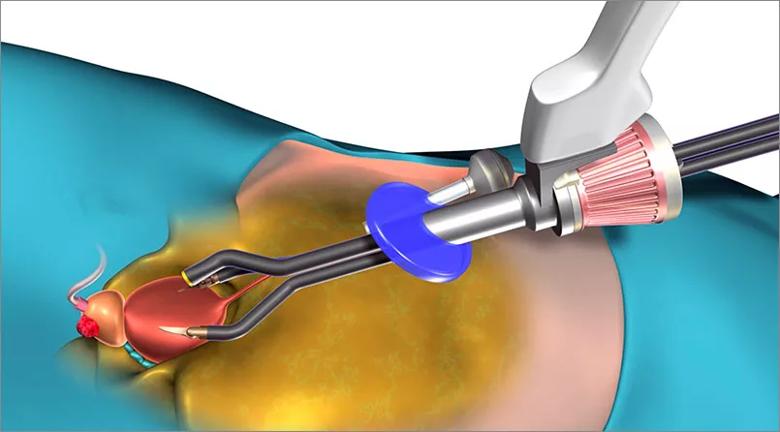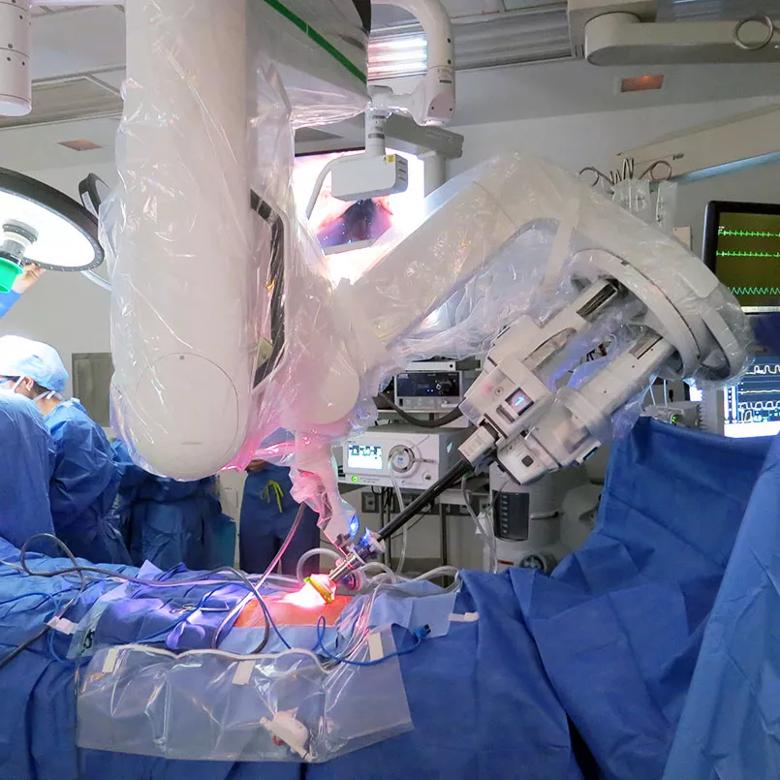Outcomes comparable to multiport robotic approach, but with less pain

Robotic radical prostatectomy used to require five incisions in a patient’s abdomen. Today at Cleveland Clinic it requires only one, using the da Vinci® SP Surgical System.
Advertisement
Cleveland Clinic is a non-profit academic medical center. Advertising on our site helps support our mission. We do not endorse non-Cleveland Clinic products or services. Policy

Single-port robotic radical prostatectomy
Cleveland Clinic was the first U.S. medical center to begin using the single-port robot for urology procedures in late 2018. Since then, experts at Glickman Urological & Kidney Institute have used it to perform extraperitoneal prostatectomy in approximately 250 patients. It’s especially beneficial in patients for whom procedures would be challenging, such as in those who are obese and those who have breathing problems.
“Performing the procedure extraperitoneally has several advantages,” says Jihad Kaouk, MD, Director of the Center for Robotic and Image-Guided Surgery and the Zegarac-Pollock Endowed Chair in Laparoscopic and Robotic Surgery. “By avoiding the sac in which the bowel is contained, the surgery is compartmentalized, limited to the area just around the prostate. The gas bubble in which the robotic arms work expands the peritoneum, pushing the bowel out of the way, allowing better visibility.”
In addition to reducing bowel-related complications, the single-port robotic technique also prevents adverse effects, such as optical nerve edema, congestion and respiratory problems during surgery, that can come from steep Trendelenburg positioning. Patients having single-port robotic prostatectomy lie flat.

Operating room setup during a single-port robotic extraperitoneal radical prostatectomy
“Thanks to these advances, radical prostatectomy has been transformed into an outpatient procedure,” says Dr. Kaouk. “Most patients go home a few hours after surgery.”
Advertisement
Outcomes are comparable to the multiport robotic approach, but with less pain and no drain except a Foley catheter. More than two out of three patients require no narcotics after surgery and are able to manage pain with only ibuprofen or acetaminophen, or no pain medication at all.
| Single-port robotic prostatectomy | Multiport robotic prostatectomy | |
|---|---|---|
| Hospital stay | 4.3 hours | 26.1 hours |
| Time in the operating room | 195 minutes | 190 minutes |
| Blood loss during surgery | 190 mL | 200 mL |
| Percentage of patients who use narcotics after surgery | 32% | 63.6% |
| Morphine equivalent | 7.5 mg | 15 mg |
| Hospital stay | ||
| Single-port robotic prostatectomy | ||
| 4.3 hours | ||
| Multiport robotic prostatectomy | ||
| 26.1 hours | ||
| Time in the operating room | ||
| Single-port robotic prostatectomy | ||
| 195 minutes | ||
| Multiport robotic prostatectomy | ||
| 190 minutes | ||
| Blood loss during surgery | ||
| Single-port robotic prostatectomy | ||
| 190 mL | ||
| Multiport robotic prostatectomy | ||
| 200 mL | ||
| Percentage of patients who use narcotics after surgery | ||
| Single-port robotic prostatectomy | ||
| 32% | ||
| Multiport robotic prostatectomy | ||
| 63.6% | ||
| Morphine equivalent | ||
| Single-port robotic prostatectomy | ||
| 7.5 mg | ||
| Multiport robotic prostatectomy | ||
| 15 mg |
Lenfant L, Sawczyn G, Aminsharifi A, et al. Pure single-site robot-assisted radical prostatectomy using single-port versus multiport robotic radical prostatectomy: a single-institution comparative study [published online ahead of print, 2020 Nov 4]. Eur Urol Focus. 2020;S2405-4569(20)30290-X.
While many centers are beginning to adopt this approach to radical prostatectomy, Cleveland Clinic has been among the first to publish findings on step-by-step techniques and cost comparisons. In the study published in 2020 in European Urology Focus, a Cleveland Clinic team reported that the overall surgical care cost of single-port prostatectomies is comparable to multiport prostatectomies. The higher cost of surgical materials in single-port procedures is offset by the lower cost of shorter hospital stays.
Another study published in 2020 in Urology presented comprehensive data on the first 100 consecutive patients to undergo single-port robotic surgery at Glickman Urological & Kidney Institute, including 60 that had radical prostatectomy.
Single-port robotic procedures also are available for partial nephrectomy, radical cystectomy and even kidney transplant. Since 2018, Cleveland Clinic has completed eight single-port kidney transplants, with no complications so far.
Advertisement
“We intend to keep minimizing incisions, possibly working toward robotic surgery with no incisions, done through natural orifices,” says Dr. Kaouk. “Advances in robotic surgery also will involve creating robots that aren’t just an extension of the surgeon’s hands and eyes, but a virtual assistant — a smart robot that can use imaging to improve surgical precision, for example.”
Advertisement
Advertisement

Pediatric urologists lead quality improvement initiative, author systemwide guideline

Fixed-dose single-pill combinations and future therapies

Reproductive urologists publish a contemporary review to guide practice

Two recent cases show favorable pain and cosmesis outcomes

Meta-analysis assesses outcomes in adolescent age vs. mid-adulthood

Proteinuria reduction remains the most important treatment target.

IgA nephropathy is a relatively common autoimmune glomerular disease that can be diagnosed only by biopsy

Oncologic and functional outcomes are promising, but selection is key